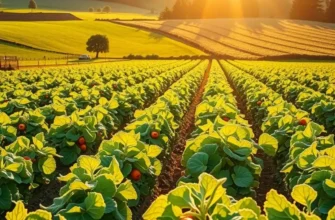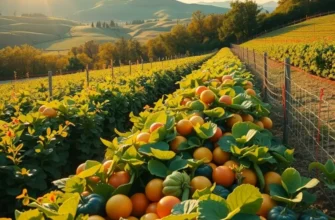Pulses, including lentils, chickpeas, and beans, offer a sustainable source of nutrition that supports both our health and the environment. By incorporating these nutrient-dense foods into our meals, we can lower our carbon footprint, enhance biodiversity, and support sustainable farming practices. As consumers become more conscious of their food choices, pulses emerge as a compelling option for those seeking to make environmentally friendly decisions. This article will explore the myriad benefits of pulses, empowering you to choose wisely for both your health and the planet.
The Environmental Benefits of Pulses

Incorporating pulses into farming practices offers significant environmental advantages, contributing positively towards sustainable agriculture. Pulses, such as lentils, chickpeas, and beans, have unique capabilities that enhance soil health. These plants house nitrogen-fixing bacteria in their root nodules, which convert atmospheric nitrogen into ammonia, a form usable by plants. This natural process reduces the need for synthetic fertilizers, which can lead to nutrient runoff and waterway pollution.
By cultivating pulses, farmers can improve soil structure and fertility. They boost organic matter in the soil, enhancing its capacity to retain water and reduce erosion. This means less compaction and more productivity from the land, sustaining agricultural capabilities in the long term.
Pulses also play a role in reducing greenhouse gas emissions. Agriculture is a major contributor to methane and nitrous oxide emissions. However, pulses emit significantly lower amounts of these gases compared to other crops. As pulses reduce the reliance on synthetic fertilizers, they help cut down on the associated carbon footprint, leading to more climate-friendly farming.
Water conservation is another area where pulses shine. They require less water compared to other protein sources. For example, the water footprint of pulses is substantially less than that of beef or lamb, making them a more sustainable choice for water-scarce environments. By shifting dietary habits towards pulses, we can reduce personal and agricultural water use, contributing to broader conservation efforts.
For those interested in reducing food waste and enhancing sustainability, meal planning with pulses can offer effective strategies. Integrating these nutrient-rich foods into daily meals not only supports health but also aligns with environmental goals. For practical tips on minimizing food waste in your own kitchen, you can explore strategies in low-waste cooking and prep.
In sum, pulses are a powerhouse in sustainable agriculture, offering multiple environmental benefits. Their ability to improve soil health, decrease greenhouse gases, and conserve water marks them as key players in the movement toward a more sustainable and eco-friendly food system. As we continue to seek sustainable solutions to global food challenges, pulses provide a viable and necessary option for both farmers and consumers.
How to Incorporate More Pulses into Your Diet

Embracing pulses in your diet is a wonderful way to nourish both yourself and the planet. Their versatility and nutritional richness make them ideal for diverse culinary adventures. Here are some ways to effortlessly integrate them into your meals.
Start with Breakfast
Begin your day by adding cooked lentils or chickpeas to your morning omelet or scramble. Their earthy taste complements eggs beautifully, providing an extra protein boost that keeps you full longer. For a plant-based option, consider a pulse-based smoothie. Use cooked white beans to make a creamy, protein-rich drink that blends well with fruits like bananas and berries.
Pulse-Infused Lunches
During lunch, pulses can easily transform a salad into a hearty meal. Toss kidney beans or black-eyed peas with fresh greens, tomatoes, and a simple vinaigrette for a quick, filling dish. Alternatively, mash chickpeas with avocado for a delicious, fiber-rich sandwich spread. This swap for traditional sandwich fillings adds not only texture but also a depth of flavor.
Delicious Dinners
For dinner, pulses can take center stage. Create a comfort-filled stew by simmering lentils with veggies like carrots and potatoes in a tomato base. This meal is cost-effective and packed with essential nutrients. If you enjoy global flavors, experiment with making dal—a savory Indian dish made primarily from split peas or lentils, cooked with spices like turmeric and cumin. This can be served alongside rice or bread for a satisfying experience.
Snacking with Pulses
Pulses make excellent snacks, too. Roasting chickpeas with a sprinkle of herbs and olive oil results in a crunchy treat great for on-the-go. Hummus, made from blended chickpeas or white beans, is another versatile snack. Pair it with fresh vegetables or whole-grain crackers. These options are not only delicious but also help avoid waste by using easily stored dry pulses.
Cooking Tips
To minimize preparation time, cook large batches of pulses and freeze them in portion-sized containers. This way, they’re always on hand to add to any meal. Also, if you take an interest in low-waste practices, you may find useful tips in this guide on reducing waste in cooking.
Finally, don’t be afraid to experiment with pulse flours like chickpea or lentil flour when baking or making batter. These can substitute for regular flour to add protein and fiber to your dishes. Experiment with these flours in pancakes or flatbreads to reap the functional benefits of pulses while exploring new tastes and textures.
With these practical ways to integrate pulses into your diet, making them a staple in your kitchen is within reach. Whether it’s a small addition or a main course, pulses can easily and effortlessly enrich your meals and align with a more sustainable lifestyle.
Final words
Embracing a diet rich in pulses is not only a nourishing choice for your health but also a significant step toward environmental stewardship. By making small changes to your eating habits, such as incorporating more lentils, chickpeas, and beans into your meals, you can contribute to a more sustainable food system. Every meal offers a chance to make a positive impact. The benefits of pulses go beyond personal wellness—they encompass the health of our planet. Together, let’s work towards a greener future, one meal at a time, by choosing pulses as an essential part of our diet.








